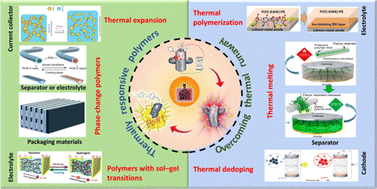Thermally responsive polymers for overcoming thermal runaway in high-safety electrochemical storage devices
Abstract
The thermal runaway of electrochemical storage devices (ESDs) under thermal abuse conditions causes many safety concerns, thus limiting their further application. However, traditional strategies of avoiding thermal runaway in ESDs are irreversible and have poor compatibility. Several strategies based on thermoresponsive polymers have been explored to prevent or inhibit the thermal runaway of ESDs due to rapid, reversible, and intelligent thermal responses at a specific trigger temperature. Herein, the recent progress in thermally responsive polymers for overcoming the thermal runaway for high-safety ESDs is summarized. Six strategies are considered: phase change, sol–gel transitions, thermal melting, thermal polymerization, thermal dedoping, and thermal expansion. The working mechanisms of these thermoresponsive polymers are discussed in turn, with a focus on the synthesis, electrochemical performance, and thermal responses for each strategy. Finally, the internal and external safety design features for preventing thermal runaway in ESDs are explored, including the optimization direction in packaging materials, electrodes, electrolytes, current collectors and separators.

- This article is part of the themed collection: 2023 Materials Chemistry Frontiers Review-type Articles


 Please wait while we load your content...
Please wait while we load your content...